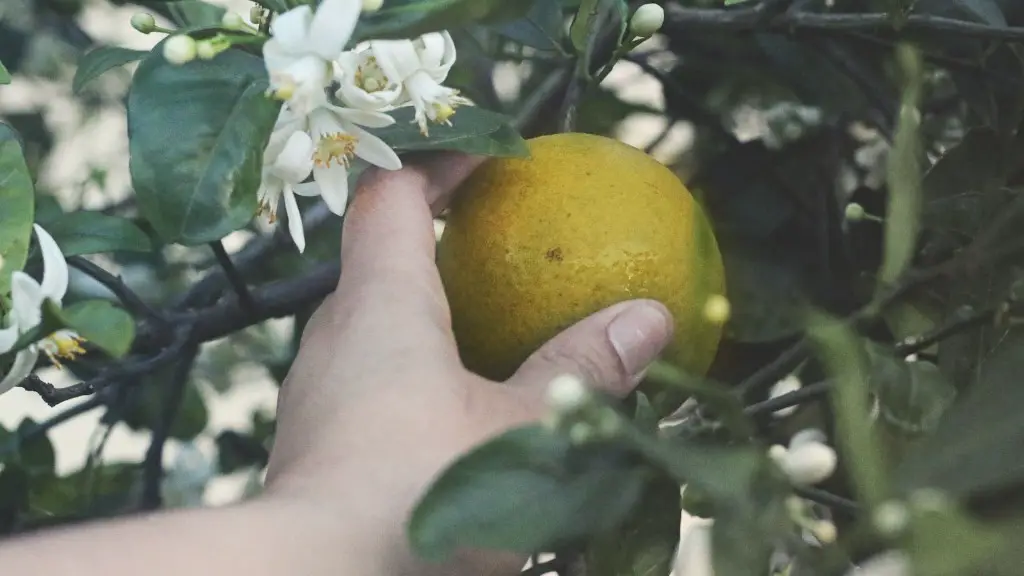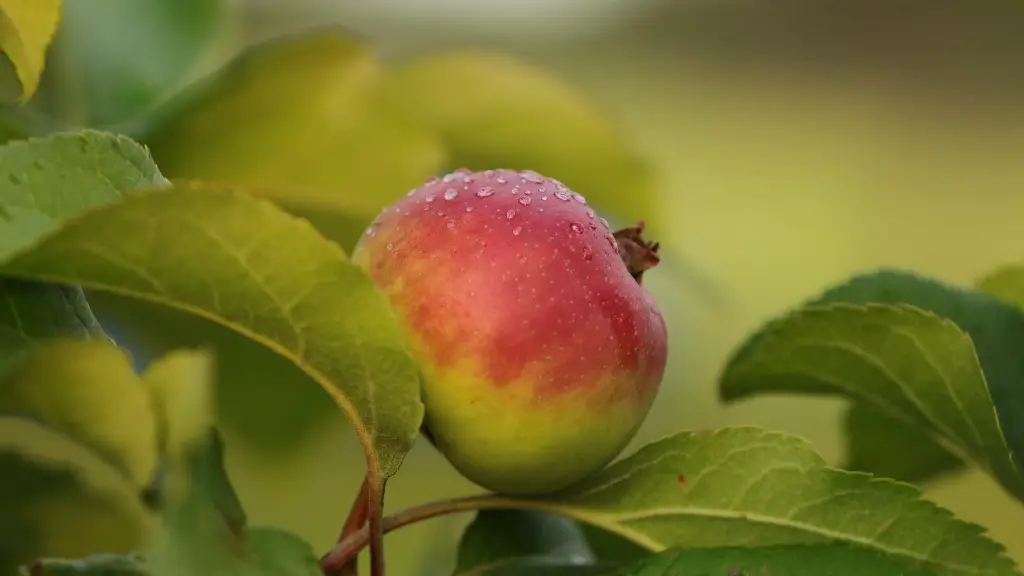Root rot in lemon trees is a common problem caused by a combination of factors, including poor drainage, excessive moisture, and poor cultural practices. There are steps that can be taken to reduce the likelihood of root rot and to treat trees that have become infected. By following these steps, growers can help ensure healthy and productive lemon trees.
The first step in treating root rot is to identify the cause. Improving drainage and reducing moisture are the most important steps to prevent and treat root rot. If conditions aren’t already conducive to ideal drainage, such as an overly compacted soil, the grower should incorporate organic matter and improve soil structure. The soil should be allowed to dry between waterings, and excess water should be removed from the planting area.
In addition to improving drainage, growers should also adjust their cultural practices to avoid root rot. Pruning should be done carefully, and any cuts should be treated immediately with a fungicide to prevent infection. Fertilizing the tree with phosphorous and potassium can help encourage healthy root development, while avoiding fertilizers high in nitrogen. When watering trees, growers should pay close attention to the frequency and quantity, especially during times of excessive heat and humidity.
In the event that root rot has already taken hold, there are steps that can be taken to save an infected tree. The first step is to remove any affected areas, cutting away any soft, rotten roots. The area should then be treated with an antifungal agent and left to dry. Next, the soil should be replanted with a fresh batch of soil, making sure to improve the soil’s drainage and structure. Finally, the tree should be encouraged to form new roots by providing deep watering and avoiding overly frequent watering.
These steps should help reduce the risk of root rot in lemon trees and treat it when necessary. Following these steps should help restore health and promote optimal growth in lemon trees.
Improving Soil Structure
Improving soil structure is an essential step in reducing the risk of root rot in lemon trees. Poorly draining soil causes water to pool around the tree’s root system, leading to prolonged periods of wetness and an increased likelihood of fungal infection. Improving soil structure helps ensure that water can drain away from the tree, reducing the possibility of root rot.
The first step to improving soil structure is to incorporate an organic matter such as compost or mulch into the soil. This will help to improve the soil’s structure and further increase its ability to drain. Additionally, incorporating organic matter into the soil will help to retain moisture and provide essential nutrients to the tree. The soil should also be tested to establish an effective soil pH and adjust it if necessary.
By improving soil structure, growers should be able to reduce the likelihood of root rot in lemon trees. Additionally, this step should also help to improve the tree’s overall health by providing essential nutrients and helping to retain moisture. As such, incorporating organic matter into the soil should be an essential part of any lemon tree care plan.
Water Management
Water is essential for plant growth, however, too much can be just as detrimental as too little. Overwatering can lead to root rot, as soil that is constantly waterlogged does not allow for proper drainage, and can leave the tree’s roots in a perpetual state of wetness. As such, effective water management is key to preventing root rot in lemon trees.
The first step to managing water is to check the tree’s soil regularly to make sure that it still has adequate levels of moisture. If the soil is overly dry, the tree should be irrigated deeply. If the soil is already wet or waterlogged, then further irrigation should be avoided. Additionally, applying mulch around the tree can help to regulate soil moisture and help keep the root system dry.
Watering only when necessary is essential for keeping a tree healthy and preventing root rot. While lemon trees need ample water, they should also be given time to dry and dry air circulation around the root system. By following these steps, growers can ensure proper water management and avoid the onset of root rot.
Fertilizing the Plant
Fertilizing is an important part of any lemon tree care plan. Fertilizers help to supplement soil nutrients, encouraging healthy growth and plant development. When selecting a fertilizer for a lemon tree, it is important to look for a formulation that is high in phosphorous and potassium, while avoiding formulations with excessive levels of nitrogen. Too much nitrogen can lead to leaf growth at the expense of root development, making the tree more prone to root rot.
Fertilizing should be done on a regular basis, with applications typically made every 1-2 months during the growing season. When applying fertilizer, it should be worked into the soil, following the manufacturer’s instructions for application rate and frequency. This ensures that the tree is receiving adequate nutrition without applying too much.
By selecting an appropriate fertilizer and applying it appropriately, growers can ensure their lemon trees receive the nutrients they need for healthy growth and avoid the onset of root rot. Additionally, monitoring the application rate and avoiding fertilizers with excessive nitrogen will help to minimize any potential risks.
Pesticides and Herbicides
While pesticides and herbicides can be effective for controlling pests and weeds, improper application can also introduce additional risks. For example, applying too much of a herbicide can damage the delicate root system, causing root rot. Additionally, introducing any toxic substance into the soil can cause a disruption in the natural microbial balance, further amplifying the risk of root rot.
When using pesticides and herbicides, it is important to follow the manufacturer’s instructions. The substance should be applied carefully and at the specified rate. Additionally, it is best to avoid applying any of these substances directly to the root system to reduce the risk of root rot.
By following these steps, growers can better protect their lemon trees from root rot. Additionally, using appropriate caution when using pesticides and herbicides will help to protect the tree’s root system and reduce the chances of root rot.
Prevention is key
Preventing root rot is preferable to treating it. The best way to protect a lemon tree from root rot is to ensure it has ample drainage and avoid overwatering. Additionally, proper soil structure and fertilization should be considered essential for optimal plant health, as should following the manufacturer’s instructions for pesticide and herbicide use.
By following these steps, growers should be able to reduce the risk of root rot in lemon trees. Additionally, these steps should also help to promote healthy growth and ensure the tree’s long-term health and productivity.
Replanting the Tree
In cases where the root system has been severely damaged, replanting may be necessary. When replanting the tree, first any affected areas should be removed, cutting away any soft or rotten roots. The wounds should be treated with an antifungal agent, and then the area should be dried thoroughly. Once the tree is replanted, the grower should take steps to improve the soil’s drainage and incorporate organic matter.
Next, the tree should be given deep waterings, but the soil should be allowed to dry between sessions. Additionally, shaded areas or coverings may be used to help protect the tree from excessive heat and humidity. By taking these steps, the tree will be better able to develop and grow new roots, and should soon be back to optimal health.
Providing Adequate Air Circulation
Air circulation is essential for lemon tree health, as it allows for exchange of gases, carries away excess moisture, and helps to promote healthy growth. To ensure adequate air circulation around the tree, pruning and trimming should be done regularly. Additionally, a space should be provided between the tree and its surrounding plants to promote airflow.
Providing adequate air circulation around the tree can reduce the possibility of root rots, as well as provide the tree with the oxygen it needs. Additionally, allowing air to move freely throughout the tree’s root system can provide cooler temperatures and reduce the likelihood of disease.
By following these steps, growers can help ensure their lemon trees have adequate air circulation, reducing the risk of root rots and encouraging healthy growth. The importance of airflow should not be underestimated, as it can play an integral role in the health and productivity of a lemon tree.





